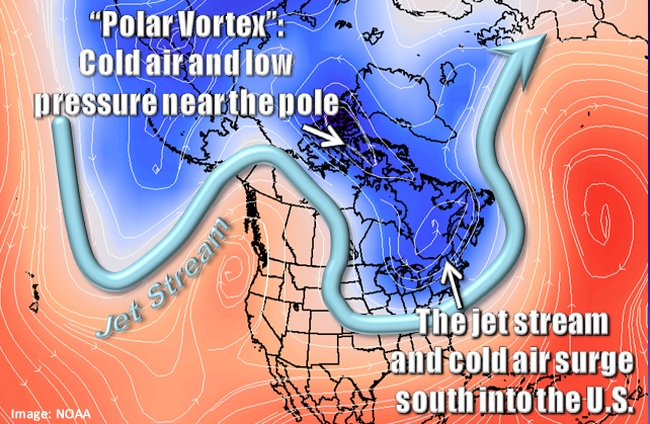The weather temperatures in the U.S. this year have been extreme. We had very hot weather in the summer, and now, very cold weather in the winter. The cold is so extreme, my friends in Chicago that have lived there for 75 years have never seen anything like it. -50 degrees means school, shopping and outdoor activities come to a halt. I'd heard about the polar vortex, but didn't really know what it was, so I found out some information on weather.gov. The following information is direct from their website,
What is the Polar Vortex?

Cold Resources
The polar vortex is a large area of low pressure and cold air
surrounding both of the Earth’s poles. It ALWAYS exists near the poles,
but weakens in summer and strengthens in winter. The term "vortex"
refers to the counter-clockwise flow of air that helps keep the colder
air near the Poles. Many times during winter in the northern hemisphere,
the polar vortex will expand, sending cold air southward with the jet
stream (see graphic above). This occurs fairly regularly during
wintertime and is often associated with large outbreaks of Arctic air in
the United States. The one that occurred January 2014 is similar to
many other cold outbreaks that have occurred in the past, including
several notable colder outbreaks in 1977, 1982, 1985 and 1989.
There are several things the polar vortex is NOT. Polar vortexes are
not something new. The term “polar vortex” has only recently been
popularized, bringing attention to a weather feature that has always
been present. It is also not a feature that exists at the Earth’s
surface. Weather forecasters examine the polar vortex by looking at
conditions tens of thousands of feet up in the atmosphere; however, when
we feel extremely cold air from the Arctic regions at Earth’s surface,
it is sometimes associated with the polar vortex. This is not confined
to the United States. Portions of Europe and Asia also experience cold
surges connected to the polar vortex. By itself, the only danger to
humans is the magnitude of how cold temperatures will get when the polar
vortex expands, sending Arctic air southward into areas that are not
typically that cold.


No comments:
Post a Comment